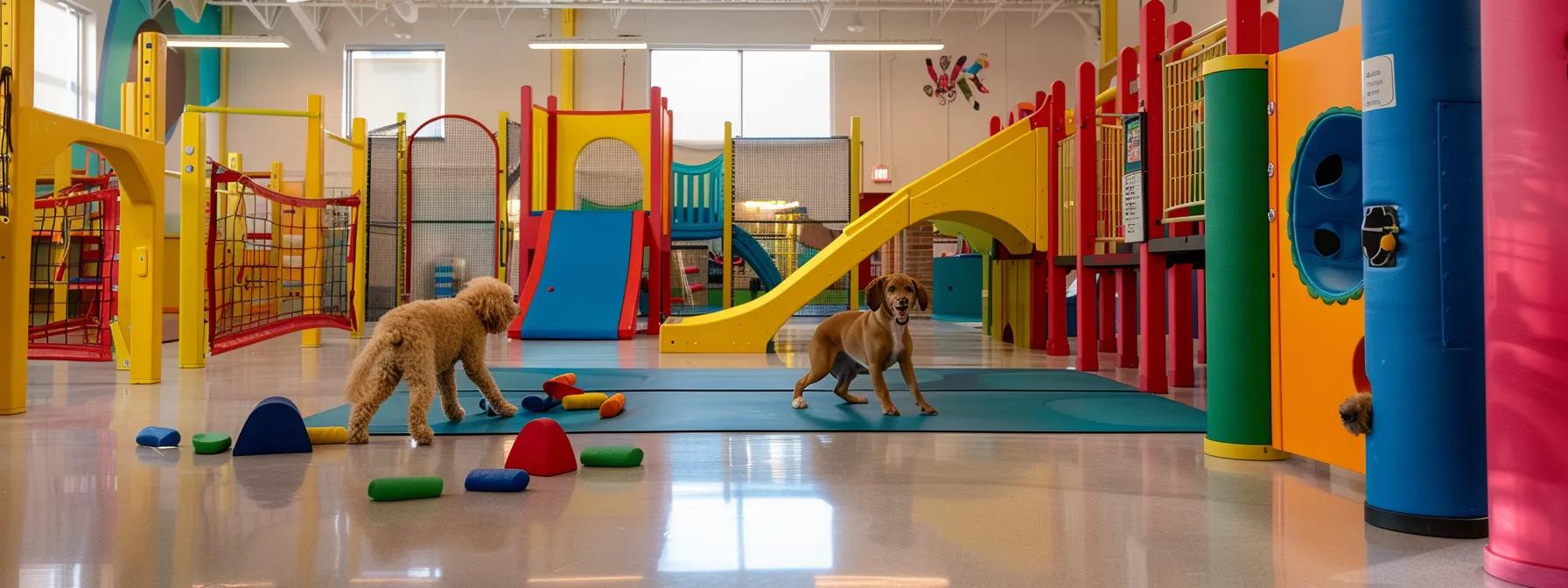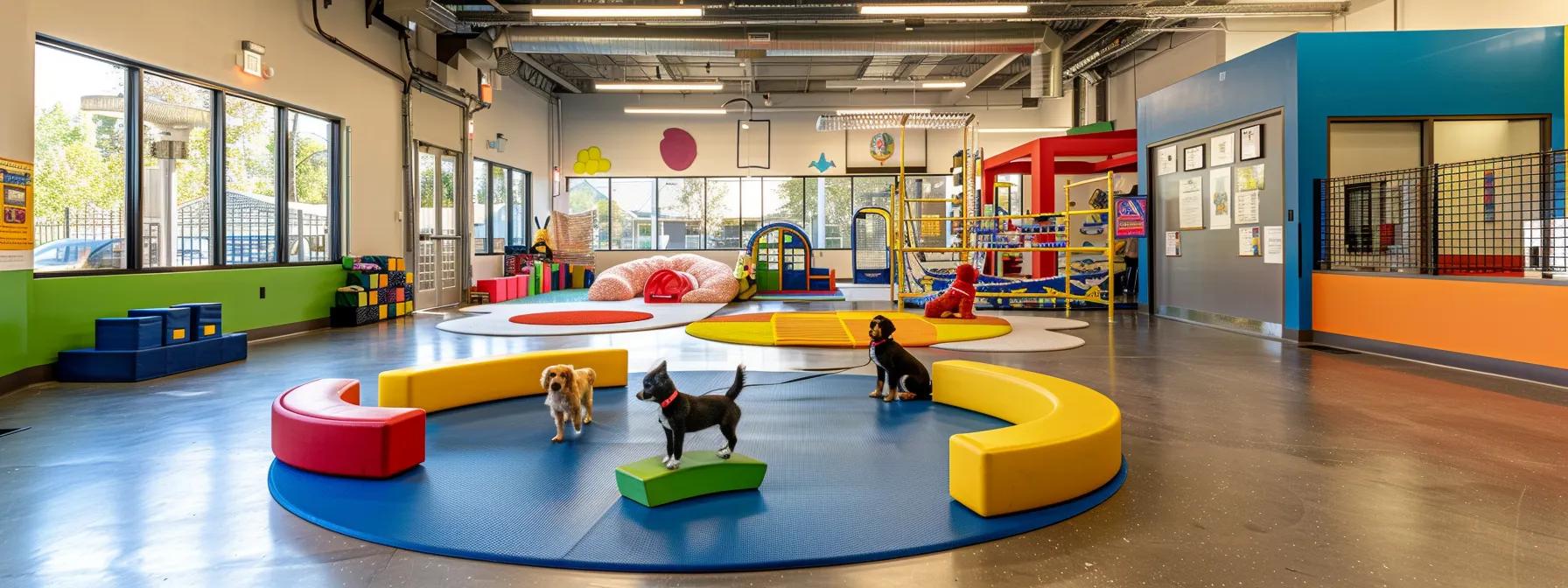Creating Effective Exercise Schedules for Dog Boarding

Creating Effective Exercise Schedules for Dog Boarding
Regular exercise is vital in a dog boarding facility to support your pet’s physical and mental wellbeing, in line with Elizabeth M. Foubert’s guidelines. A structured exercise schedule can boost your dog’s overall health, aiding socialization, confidence, and temperament adjustment. These routines, when planned correctly, enhance the dog’s agility, reduce stress, and maintain energy levels throughout their stay, ensuring a happy pup manor experience that mirrors expert dog training and daycare standards.
Physical Health Benefits of Consistent Exercise Schedules in Dog Boarding

Establishing routine physical activity in boarding helps maintain a healthy weight, supports cardiovascular fitness, and enhances overall physical coordination. Regular movement reduces kennel-related health issues and assists digestion, preventing constipation. It also promotes joint mobility and proper muscle tone, ensuring your dog remains agile and balanced despite the stress of being away from home.
Maintaining Healthy Weight Through Regular Activity at Kennels
Regular exercise burns excess calories, keeping your dog fit and preventing obesity. It encourages consistent body condition, improving energy levels and overall health while supporting efficient metabolism during boarding.
Supporting Cardiovascular Fitness With Structured Dog Boarding Exercise
Structured exercise stimulates heart function and increases circulation. Improved cardiovascular fitness helps reduce stress, ensures efficient oxygen utilization, and supports a resilient heart in busy kennel environments.
Promoting Joint Mobility and Muscle Tone in Boarded Dogs
Active routines strengthen muscles and lubricate joints. This enhances mobility, reduces stiffness, and supports healthy muscle tone, crucial for maintaining natural movement and reducing injury risks during extended boarding periods.
Aiding Digestion and Preventing Constipation via Activity Plans
Activity stimulates gastrointestinal motion. Regular walks and play help maintain proper digestion and prevent constipation by encouraging healthy bowel movements and easing stress-induced digestive issues.
Reducing Risks of Kennel-Related Health Issues
Exercise minimizes sedentary behavior and reduces weight-related problems, easing pressure on joints and internal organs. This systematic movement helps avert issues like hypokinetic disease within the constrained environment of a kennel.
Mental Wellbeing and Behavior Improvements From Dog Boarding Exercise Routines

Regular physical activity in a kennel setting not only boosts physical health but also improves mental wellbeing. Structured exercise releases endorphins, alleviating stress and anxiety while preventing boredom. It contributes to better sleep patterns, fosters positive emotions, and encourages smoother social interactions with other dogs, ultimately enhancing overall behavior and temperament during boarding stays.
Alleviating Stress and Anxiety With Regular Physical Outlets
Routine exercise provides an outlet for pent-up energy, reducing stress hormones and creating a calm mental state. This regulation contributes to a peaceful environment even in busy boardings.
Preventing Boredom and Destructive Behaviors Through Engagement
Engaging routines prevent destructive behaviors that often stem from boredom. It channels energy into play and structured training, fostering a balanced and content pet experience in the boarding facility.
Enhancing Mood and Temperament With Endorphin Release
Physical activity triggers endorphin release, elevating your dog’s mood. This positive biochemical response assists in building confidence and helps maintain a friendly temperament throughout their stay.
Supporting Better Sleep Patterns for Boarded Canines
Regular exercise sets a natural rhythm, helping dogs settle into deeper, more restorative sleep cycles. Improved sleep enhances cognitive functions and overall recovery after active play.
Facilitating Smoother Social Interactions With Other Dogs
Scheduled group activities promote safe socialization with peers. This exposure builds positive social skills, reduces anxiety during new encounters, and helps dogs better adapt to varied environments.
Tailoring Exercise Schedules in Dog Boarding to Individual Needs

Every dog is unique, requiring exercise tailored to its breed, age, energy, and temperament. Customizing activity plans ensures that each dog gets sufficient stimulation without overexertion. Adjustments based on health conditions and behavioral tendencies maximize benefits while keeping routines enjoyable and safe in a boarding facility that values both physical exercise and expert dog training.
Considering Breed Characteristics in Canine Activity Plans at Kennels
Different breeds have varied exercise needs. High-energy breeds may require longer runs, whereas smaller or less active breeds benefit from shorter, gentler play sessions to maintain optimal fitness.
Adapting Exercise Intensity for Age and Health Conditions
Young dogs and healthy adults can engage in vigorous activities. Older dogs or those with health concerns need moderated sessions to prevent stress and ensure safe mobility within the kennel environment.
Incorporating Individual Energy Levels Into Daily Routines
Each dog’s daily energy output varies. Tailoring sessions according to a dog’s mood or recent activity allows maintenance of enthusiasm while balancing exertion with rest periods.
Modifying Activities Based on Temperament and Social Preferences
Shy or anxious dogs may thrive with one-on-one play, while extroverted dogs can benefit from group runs. Adjusting for temperamental differences ensures all dogs have stress-free, engaging activities.
Documenting and Adjusting Exercise Schedules for Optimal Benefit
Tracking daily activity levels helps staff fine-tune routines. Regular reviews ensure schedules match the dog’s evolving needs, providing continuous improvement in physical and behavioral outcomes.
Key Components of Effective Exercise Schedules in Dog Boarding Facilities

An effective exercise regimen in a boarding facility relies on variety, duration, safe settings, skilled supervision, and integration of play with focused activity. These elements ensure dogs receive balanced exercise to support physical health and positive behavior while meeting industry standards seen in premium dog daycare and training programs.
Variety in Activities to Keep Dogs Engaged
Introducing diverse activities—such as walks, play sessions, and agility courses—prevents monotony and maintains high engagement. Variety also supports multiple aspects of fitness and socialization.
Appropriate Duration and Frequency of Exercise Sessions
Optimal routines strike a balance between active periods and restful breaks. Frequent, scheduled sessions prevent fatigue while ensuring sustained health improvements without overwhelming the pet.
Safe and Stimulating Environments for Canine Activity
Ensuring exercise areas are secure, clean, and equipped with proper grooming and play equipment minimizes injury risks and promotes an atmosphere of effective dog boarding.
Qualified Staff Supervision During Dog Boarding Exercise
Skilled staff monitor exercise sessions to ensure safety, offer instant support, and use expert dog training techniques during group and individual play, bolstering overall care.
Integrating Playtime With Purposeful Physical Training
Blending fun activities with structured training makes exercise enjoyable and beneficial. This combination enhances agility, obedience, and social skills, creating a positive experience for both dogs and pet owners.
How Pet Owners Can Evaluate a Facility’s Approach to Exercise Schedules in Dog Boarding
When choosing a dog boarding facility, assess how they structure exercise routines. Ask about daily activity plans, observe play areas, review staff qualifications, and check policies on group versus individual play. Transparency and quality of exercise schedules strongly influence your dog’s physical and emotional health, offering insights into expert dog training and kennel management.
Questions to Ask About Daily Canine Activity Plans
Inquire about duration, frequency, and types of activities. Ask how the facility adapts plans for different breeds or energy levels to ensure each dog receives tailored exercise.
Observing Exercise Areas and Equipment Quality
Inspect play zones for safety and stimulation. Quality equipment and well-maintained facilities indicate a serious approach to canine fitness and stress management.
Understanding Staff Training for Managing Dog Exercise
Ask about certifications and experience in dog training programs. Well-trained staff ensure safe execution of exercise and behavioral guidance during each session.
Reviewing Policies on Group Play Versus Individual Activity
Evaluate whether the facility offers balanced group socialization and one-on-one attention. Effective policies cater to both socialization and individual temperamental needs for a happy pup manor experience.
Seeking Transparency in How Exercise Schedules Are Implemented
Request documentation of daily routines and tracking methods. Transparent practices reflect commitment to continuous improvement in dog daycare and boarding quality.
The Role of Well-Planned Exercise Schedules in Dog Boarding Success
Well-planned exercise schedules lead to a positive boarding experience, foster trust with pet owners, reduce behavioral problems, and set a benchmark for quality canine care. These systematic routines ensure that dogs remain healthy, socially adjusted, and content, ultimately helping them return home calm and balanced after each stay.
Contributing to a Positive Boarding Experience for Dogs
Consistent exercise helps maintain high energy and improves overall mood, resulting in a constructive boarding vibe that eases separation anxiety and bolsters social skills during the stay.
Building Trust and Confidence With Pet Owners
Transparent, tailored exercise routines demonstrate a facility’s commitment to quality care. This builds trust and confidence among pet owners, ensuring ongoing loyalty and positive recommendations.
Minimizing Behavioral Problems Within the Kennel Environment
Structured physical activity reduces boredom and stress, curbing destructive behaviors. A well-managed exercise schedule supports consistent, calm, and friendly interactions among boarding dogs.
Setting a Standard for Quality Canine Care
A comprehensive exercise approach reflects expert dog training and boarding practices. High standards motivate ongoing improvements in facilities, ensuring better overall care for every dog.
Ensuring Dogs Return Home Healthy and Content
By promoting physical health and mental stability, regular exercise ensures your pet remains relaxed and happy. This outcome is crucial for a successful boarding experience that meets both owner expectations and premium dog daycare standards.
Conclusion
A structured exercise schedule in dog boarding positively influences physical health, behavioral balance, and overall wellbeing. By tailoring activities to individual needs and ensuring safe, engaging routines, facilities can boost fitness while reducing stress. Pet owners are encouraged to review these practices when choosing a kennel and trust that a thoughtful approach results in healthier, happier dogs.
Frequently Asked Questions
Q: How do regular exercise schedules improve my dog’s health at boarding?
A: Consistent activity manages weight, boosts cardiovascular health, and enhances joint mobility while reducing stress and digestive issues.
Q: What benefits do mental health routines offer in a kennel environment?
A: Regular exercise releases endorphins, reducing anxiety and boredom while improving mood, sleep, and social interactions.
Q: Can exercise routines be customized for different breeds?
A: Yes, exercise plans can be tailored based on breed characteristics, age, energy levels, and health conditions for more effective care.
Q: How do I assess a facility’s exercise schedule?
A: Ask specific questions about daily routines, observe the equipment and play areas, and review staff qualifications to ensure optimal care.
Q: What overall impact does structured exercise have in boarding facilities?
A: It provides a balanced routine that minimizes behavioral issues, builds owner trust, and ensures dogs return home healthy and emotionally content.











